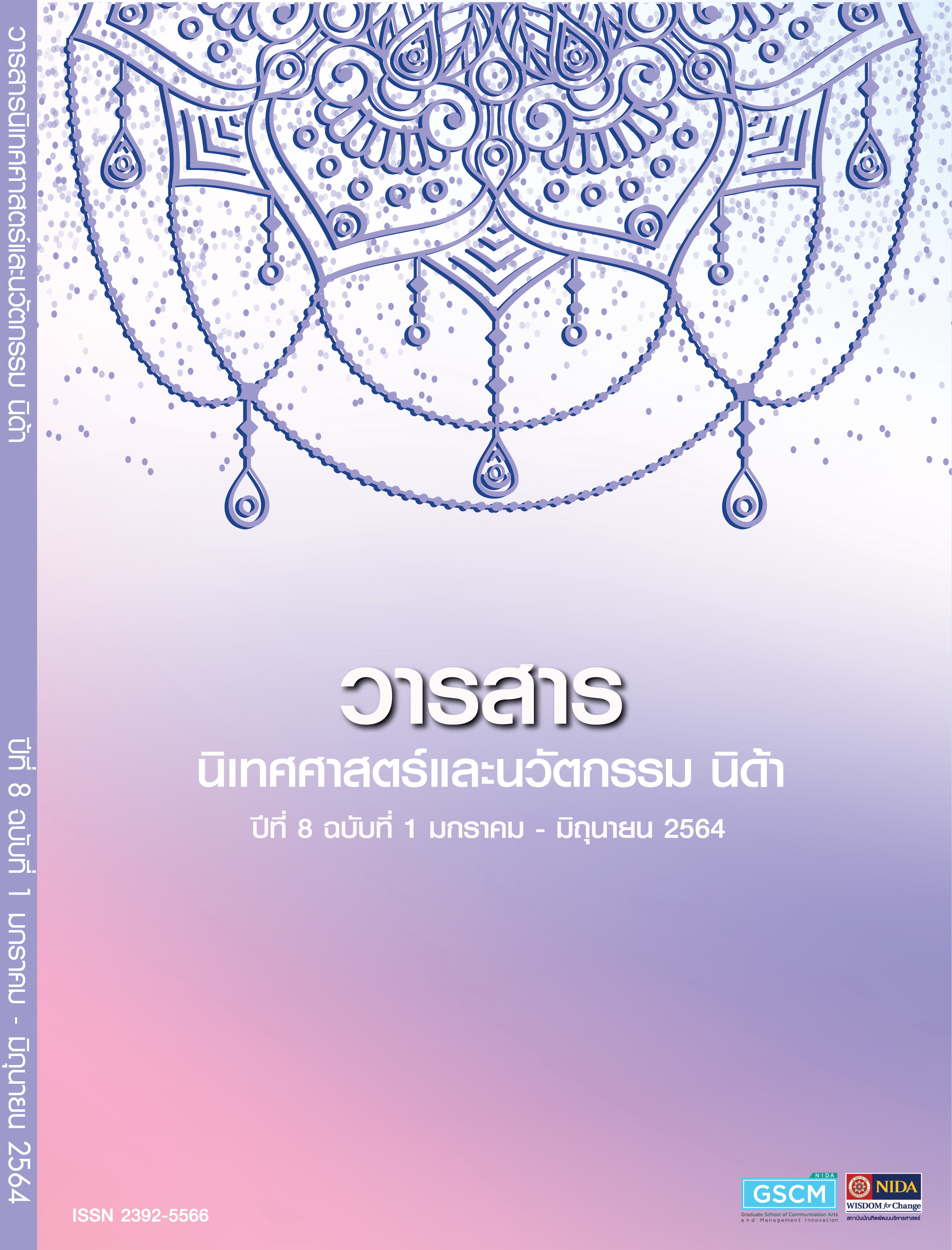Consumer’s Exposure, Engagement and Behavior of Ordering Food Via Application
Main Article Content
Abstract
The objectives of this quantitative research studied consumer’s exposure, engagement and behavior of ordering food via food delivery application. The researcher used online questionnaires to collect the data from 390 respondents who is 18 – 45 years old, living in Bangkok and ordering food via food delivery application last 3 months, LINEMAN application 130 respondents GrabFood application 130 respondents and GET application 130 respondents. There are two sampling methods: 1. Non-probability sampling uses a specific sample selection method. 2. Volunteer sampling provides the sample as a candidate to respond to the questionnaire in person. The statistical techniques were used for analyzing the data were frequency distribute, mean, percentage, standard deviation, Pearson’s correlation coefficient and Multiple Regression Analysis.
The result showed that 1). Consumers’ exposures from food delivery application are a medium level, especially from the symbol at a shirt or a bag’s officer. 2). Engagement of consumers is a high level. Consumers are regrated by lacking of LINEMAN, GrabFood and GET! for ordering food. 3). Consumer’s decision making is a high level 4). Consumers’ exposure and engagement showed relationship with consumer’s decision making with statistical significance at 0.01. 5). Engagement of consumers affect consumer decision making, ordering food via application.
Article Details
ข้อความและความเห็นในวารสารนิเทศศาสตร์และนวัตกรรม นิด้า เป็นของผู้เขียนแต่ละท่าน มิใช่ของคณะนิเทศศาสตร์และนวัตกรรมการจัดการ สถาบันบัณฑิตพัฒนบริหารศาสตร์
References
ชเนศ ลักษณ์พันธุ์ภักดี. (2560). ปัจจัยที่มีอิทธิพลต่อการตัดสินใจใช้บริการสั่งอาหารแบบเดลิเวอรี่ผ่านสื่ออิเล็กทรอนิกส์ในเขตกรุงเทพมหานครและปริมณฑล (การค้นคว้าอิสระปริญญามหาบัณฑิต). มหาวิทยาลัยธรรมศาสตร์, กรุงเทพมหานคร.
ณัฐรุจา พงศ์สุพัฒน์. (2561). การศึกษาตลาดแอปพลิเคชันอาหารและพฤติกรรมผู้บริโภคต่อการตัดสินใจเลือกใช้บริการแอปพลิเคชันอาหาร (การค้นคว้าอิสระปริญญามหาบัณฑิต). มหาวิทยาลัยธรรมศาสตร์, กรุงเทพมหานคร.
ตรีสุนันท์ อุปรมัย. (2560). ปัจจัยที่ส่งผลต่อการตัดสินใจใช้แอปพลิเคชันไลน์แมนสั่งอาหารของผู้บริโภคในเขตกรุงเทพมหานครและปริมณฑล (การค้นคว้าอิสระปริญญามหาบัณฑิต). สถาบันบัณฑิตพัฒนบริหารศาสตร์, กรุงเทพมหานคร.
ธนาคารกสิกรไทย. (2562). อยากกินต้องได้กิน SME ร้านอาหารปรับรับ Food Delivery. สืบค้นจาก https://kasikornbank.com/th/business/sme/KSMEKnowledge/article/KSMEAnalysis/Pages/Food_Delivery.aspx
ธีรวิทย์ ชาญโกเวทย์. (2559). การเปิดรับและทัศนคติของผู้ขับขี่ยานพาหนะต่อสื่อดิจิทัลบอร์ด ในเขตกรุงเทพมหานคร. วารสารการสื่อสารและการจัดการนิด้า, 2(3), 115-126.
ลงทุนศาสตร์. (2562). สรุปข้อมูลบริษัท Grap: Grab การลงทันเสี่ยงเหลือเกิน. สืบค้นจาก https://www.investerest.co/business/the-story-of-grab/
วงศกร ยุกิจภูติ. (2559). ปัจจัยที่มีผลต่อความผูกพันในแอปพลิเคชัน Line ของผู้ใช้งานในกรุงเทพมหานคร (วิทยานิพนธ์ปริญญามหาบัณฑิต). สถาบันบัณฑิตพัฒนบริหารศาสตร์, กรุงเทพมหานคร.
วิเลิศ ภูริวัชร. (2553). Marketing is all around. กรุงเทพมหานคร: กรุงเทพธุรกิจ Bizbook,
สสินาท แสงทองฉาย. (2560). ปัจจัยส่วนประสมทางการตลาดที่มีอิทธิพลต่อพฤติกรรมของผู้บริโภคกลุ่มดิจิทัลเนทีฟไทยในการเลือกใช้แอปพลิเคชันสั่งและจัดส่งอาหารในเขตกรุงเทพมหานคร (วิทยานิพนธ์ปริญญามหาบัณฑิต). จุฬาลงกรณ์มหาวิทยาลัย, กรุงเทพมหานคร.
สำนักงานพัฒนาธุรกรรมทางอิเล็กทรอนิกส์. (2562). รายงานผลการสำรวจพฤติกรรม ผู้ใช้อินเทอร์เน็ตในประเทศไทย ปี 2562. กรุงเทพมหานคร: สำนักงานพัฒนาธุรกรรมทางอิเล็กทรอนิกส์.
สำนักงานพัฒนาธุรกรรมทางอิเล็กทรอนิกส์. (2563). ETDA เผย คน Gen-Y สั่งอาหารออนไลน์มากสุด และกว่า 40% สั่งเพราะหวั่นโควิด-19. สืบค้นจาก https://www.etda.or.th/content/online-food-delivery-survey-during-the-prevention-of-covid-19.html
สุรภี ฤทธิ์มาก. (2560). ปัจจัยที่มีผลต่อความตั้งใจใช้แอปพลิเคชันไลน์ฟู้ด (Line Food Application) ของผู้บริโภคในเขตกรุงเทพมหานคร (การค้นคว้าอิสระปริญญามหาบัณฑิต). มหาวิทยาลัยรามคำแหง, กรุงเทพมหานคร.
Aom_sin. (2562, 24 พฤษภาคม). ไขข้อข้องใจ สั่งอาหาร Lineman-grab food-get food แอปไหนคุ้ม, ใครมีบวกราคา, โปรโมชั่นมาแรงที่สุด?. สืบค้นจาก https://droidsans.com/vs-lineman-grabfood-getfood/
Just222. (2563). ไขรหัสความสำเร็จ Grab กับบริการ food delivery ที่ครองใจคนไทยทั้งประเทศ. Marketeer. สืบค้นจาก https://marketeeronline.co/archives/178476
Marketing Oops!, (2560). แกร็บ ตั้งเป้าสู่การเป็น Daily Apps ส่ง “GrabFood” ลงสนามธุรกิจอาหารเดลิเวอรี่. สืบค้นจาก https://www.marketingoops.com/news/brand-move/grab-food/
Sale Here. (2562, 24 พฤษภาคม). ไทม์ไลน์ [เฟซบุ๊ก เพจ]. สืบค้นจาก https://www.facebook.com/salehere/photos/a.638704542884328/2370192549735510/?comment_id=2370331176388314
Anderson, E. W., Fornell, C., & Lehmann, D. R. (1994). Customer satisfaction, market share, and profitability: Findings from Sweden. The Journal of Marketing, 58, 53-66.
Katz, E., & Lazarsfeld, P. F. (1998). Personal influence: The part played by people in the flow of mass communications. Glencoe, IL: Free Press.
Keller, K. L. (2013). Strategic brand management: Building, measuring, and managing brand equity (4th ed.). Harlow: Peason.
Kotler, P. (2003). Marketing management (11th ed.). Upper Saddle River, NJ: Prentice-Hall.
Mollen, A., & Wilson, H. (2010). Engagement, telepresence, and interactivity in online consumer experience: Reconciling scholastic and managerial perspectives. Journal of Business Research, 63(9), 919-925.
Paul, J. P., & Olsen, J. C. (1994). Understand consumer behavior. Ilion’s: Irwin.
Shimp, T. A. (2010). Integrated marketing communications in advertising and promotion. Mason, Ohio: South-Western Cengage Learning.
Solomon, M. R. (2015). Consumer behavior buying having, and being (11th ed). Edinburgh Gate, England: Pearson Education


